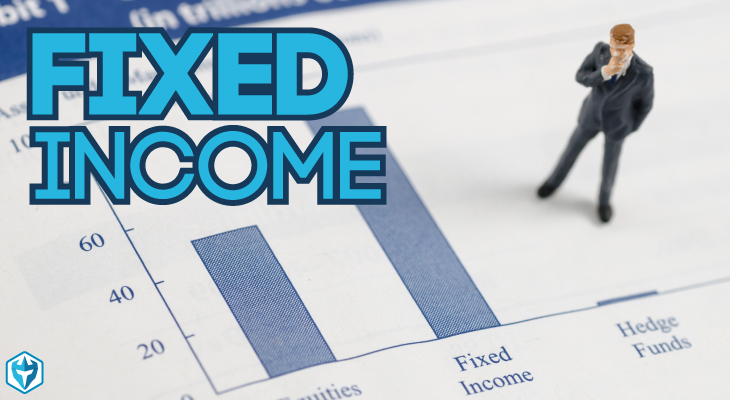FIXED INCOME
FIXED INCOME

These are broadly investment securities that pay fixed interest consistently over time. Investors are then paid their principal amount on an agreed date. Fixed income are different from the conventional common stocks; they are like preferred stocks. When the company offering these bonds are under bankruptcy, the investors in fixed income are paid first even before the common stock holders.
Government and companies raise funds by issuing debt-securities when they are looking for ways to finance large projects or run their everyday operations. The government or company in question can receive the investment capital (Face or par value) and will pay an interest rate which is agreed, within a period agreed (annually, semi-annually, quarterly or monthly); the capital is paid back after the duration of the bond.
This investment technique is best for investors that are seeking to have a diversified portfolio that will protect their funds from volatile assets like those from common stocks. Government bonds have the backing of the government while bonds from companies are backed by the financial viability of the company. It is great for investors that are conservative and the percentage allocated is investor-dependent; the investment is always with income generated from low-risk securities and popular in the port-folio of people approaching or in retirement because they can help people plan their expenses. Although MLC can give beneficial advice for asset allocation by understanding the financial goals, age, risk appetite, etc., of the investors, majority of investors take the easy route and invest 50% in stocks and 50% in fixed income (bonds), however this can be maximized for better profit making.
Strategy for Investing and maximizing most fixed income bonds
The most popular strategy for maximizing profit from bonds us called ‘The Laddering Strategy’. This strategy is very important because it avoids the interest rate risk. For example, bonds that will last for years will not afford the investor the ability to capitalize on rising interest rates. The best way to curb this to set the duration of say a 3-year bond to about a year each; this will mean that you will have 3 bonds for each year, and when the capital is retrieved for the first year, it can be invested in the fourth year. This beats the risk of missing interest rate.
TYPES OF FIXED INCOME FUNDS
Income producing funds is different and have diverse levels of risk. Below are some of the major fixed income funds.
GOVERNMENT BONDS
Investors typically invest their funds in these bonds issued by autonomous governments and agencies of the government that have the approved authority to issue debt, and international agencies, such as the World Bank and International Monetary Fund. These bonds vary in interest and duration as determined by the government in question.
MUNICIPAL BONDS
These bonds are also government issued, but the difference is that they are issued by the state/local government. These bonds are good because they avoid taxes from the Federal government as it is used to raise capital for funding local/state expenditures.
CORPORATE CREDIT
These funds typically invest in bonds, preferred stocks, and other types of fixed-income instruments representing debt issued by private corporations. The fact that these bonds are issued by private corporations makes them riskier than government or municipal bonds. These risk depends on the private corporation in question. They generally offer more income opportunity.
MULTI-SECTOR
These funds are diversified to take advantage of the changing markets. They invest in fix-income instruments like government and corporate bonds, etc.
BANK LOANS
They can offer higher interest than corporate bonds; meaning that there are riskier. They represent participation in loans to private corporations underwritten by commercial banks, etc.
CURRENCIES
These funds are liable to consistent fluctuation because they are invested in the currencies of foreign countries. Hence it will be an advantage is the currencies of the foreign country is growing stronger than your home country; if the reverse is the case, it will be a disadvantage. Investors will have to convert the funds into that of the currency of the foreign country to buy the bond.
OUR EMPHASIS ON THE IMPORTANCE OF INDEPENDENT
RESEARCH
One of our core value is knowledge and we consistently emphasize this in fixed income funds and we understand the benefits of carrying out independent research granting us the greatest opportunity to offer our clients holistic growth
UTILIZE MULTIPLE RESEARCH PERSPECTIVES
Having multiple perspectives help us cover all areas while researching. We employ the top-down macro analysis and bottom-up sector analysis to achieve this
COMMIT TO THE LONG TERM
Investing generally deals with long term sustainability and since sustainability is one of our core value, we are committed to ensuring that our partners and clients invest in sustainable markets as we employ a long-term approach, even from our personal goals and the people we hire.
OUR INVESTMENT METHODOLOGY
Majority of investors are right when they say that investing in fixed income brings the lowest possible gains. The pros and cons of the fixed income investing is listed below. However, we curb some of these cons by employing diverse techniques like the ‘Laddering strategy’ to avoid interest rate risk, and a sector-by-sector research-oriented approach.
Long term stability is gotten from fixed income investments as a well as a relatively higher ROI that your traditional savings account. This is perfect for people planning for retirement, diversification of portfolio and saving for the short-term.
Why Fixed Products?
Fixed income investment products are an important part of many portfolios. Their opportunities for use are diverse and can help investors by:
- They provide a steady and stable income stream
- More stable returns than common stocks
- Higher claim to the assets in bankruptcies
- Government and FDIC backing on some
- A better hedge for the volatility of the market. Helping to reduce downside risk.
- Guaranteed returns of short-term savings
- A key tool for portfolio diversification, especially for retirement accounts
- Lower returns than other investment types
- Can be liable to interest rate risk
- Can be affected by inflation

